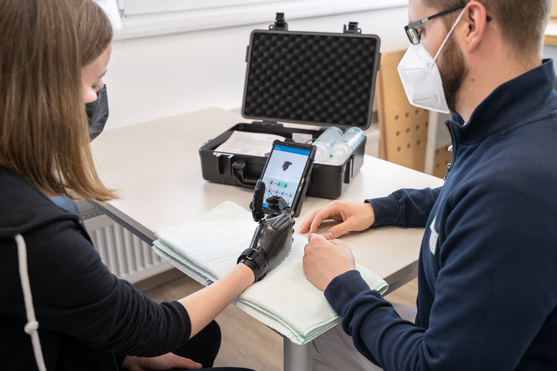Learn more about the different amputation levels of the upper extremities.
From finger to shoulder: What are the different types of prosthesis?
If you have a dysmelia, a functional aid helps you perform a certain activity.

Holistic and interdisciplinary approach
Using your prosthesis in everyday life
We want your prosthesis to make you more mobile and independent. But the best prosthesis has no benefit at all if you don't use it in your everyday life.
That’s why we never look at prosthesis care in a vacuum, but always as part of a holistic therapy concept that can only be implemented in close cooperation with physicians and therapists. We make sure that you not only get a prosthesis that is perfectly tailored to you, but that you also learn how to handle it and use it in your everyday life.
Physiotherapeutic exercises with high-tech prosthesis
Wolfgang is a young farmer who lost his right forearm due to a tragic work accident. He was one of the first patients to test a very special myoelectric arm prosthesis with the pattern recognition system, with which he can flow from one grip to the next.

Nina was born without fingers. In the past, she has actually managed very well with her hand deformity (dysmelia), but now, in her teens, she would like to use a hand prosthesis with which she can exercise different grips.
Our physiotherapist, who is specialized in hand and arm prosthetics, practices with Nina how she can use her prosthesis in everyday life. Of course, fun must not be neglected in the process! ;)

Physiotherapy & orthopedic technology hand in hand
Therapy measures
If you have been amputated, early therapeutic measures will begin for you right after your amputation. They are designed to prepare you to wear a prosthesis.
- Edema therapy (= therapy for decongestion in the event of fluid accumulation in the stump) by lymphatic drainage or compression therapy
- Preparation of skin and scar tissue for wearing the prosthesis
- Ensure mobility and strength of adjacent joints
At the beginning of your prosthesis treatment, various tests will take place to find out which device best suits you and your requirements.
If, for example, you receive a myoelectrically controlled prosthesis, we will determine the optimal electrode positions for you to use later on (=myo-test).
The selection of prosthesis fitting parts and the implementation of validated test procedures for the paying agency are also fundamental components of our interdisciplinary therapy concept.

Once we have built your interim prosthesis, the use training begins. In this special training you will learn how to handle your new prosthesis. Whether you have a dysmelia / hand deformity or amputation, our physiotherapists and orthopedics technicians will train you in the everyday use of your prosthesis in the same way:
- handling the prosthesis (putting on and taking off the prosthesis, cleaning the prosthesis, stump care, etc.)
- familiarizing yourself with and train the specific functions of the prosthesis (=functional training) and the relevant fitting parts, e.g. grip options, positioning of the wrist, learning the switchover signals, etc.

- training of everyday activities such as putting on and taking off, personal hygiene, homework, eating, drinking, writing, etc.
- muscle building (strength exercises with and without prosthesis support and torso training)
Throughout the rehabilitation process, you will receive intensive support from your therapists, physicians and orthopedic technicians. Ultimately, however, your personal motivation and your cooperation play a decisive role in the success of your prosthesis treatment.
MyoCamp
We hold a MyoCamp event for young prosthetic arm users every two years. Together with a competent team of physiotherapists and orthopedic technicians, we provide fun ways of learning how to use the myoelectric arm prosthesis.
The popular camp usually lasts several days and offers children and their parents an excellent opportunity to make new contacts or meet friends again.

Let yourself be inspired! We follow many interesting patients during their Pohlig appointment and give you personal insights.

For those who want to delve even deeper into the subject, we have a suitable video for almost every area of treatment!

Take a look behind the scenes at Pohlig and learn about different health conditions and our innovative assistive technology solutions!

Sometimes funny, sometimes explanatory, sometimes emotional - but above all always entertaining: our videos on TikTok!
If a missing part of the body hurts
Phantom pain

Some patients experience phantom pain after amputation. You feel pain supposedly from the amputated part of the body. Other symptoms such as itching, cold and heat are also possible. The explanation for this is relatively simple: After amputation of a part of the body, the brain remains functional. For example, amputees can still imagine moving their hand. If the corresponding area is activated, phantom pain may occur. However, the good news is that we can treat phantom pain more effectively, thanks to newly developed techniques. Feel free to contact us!



